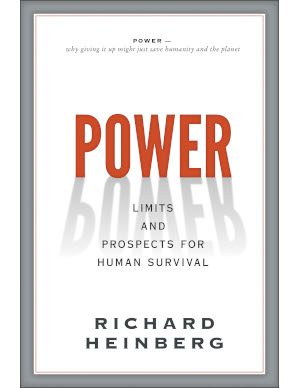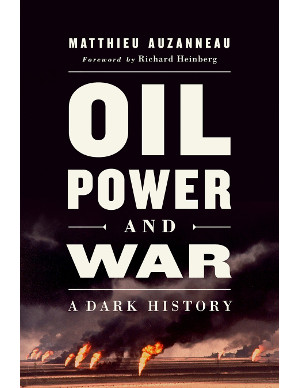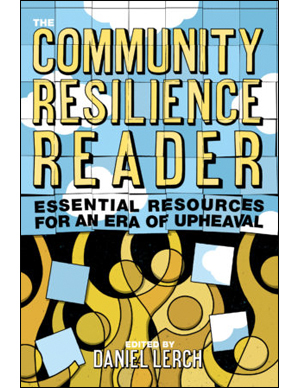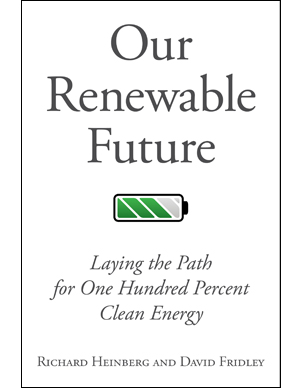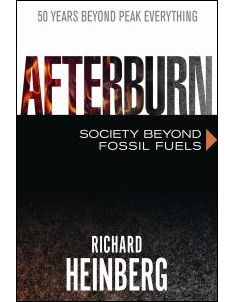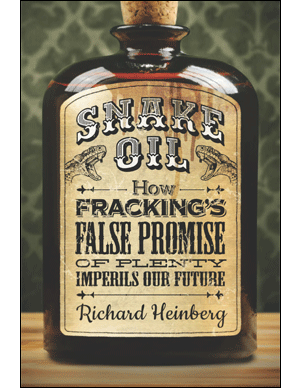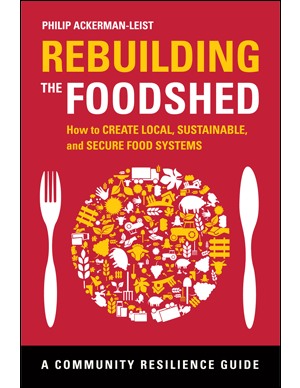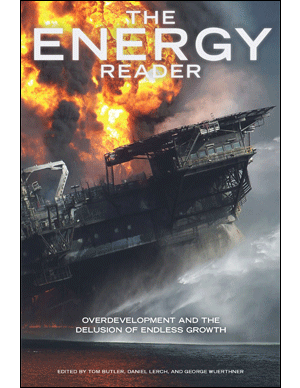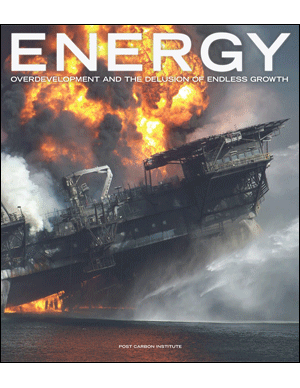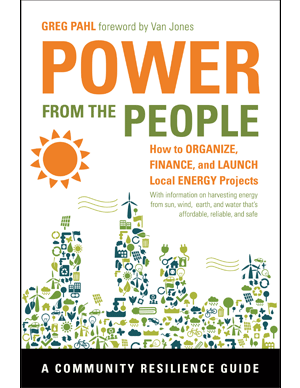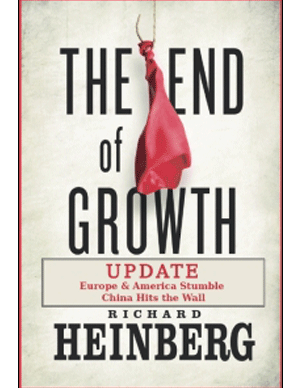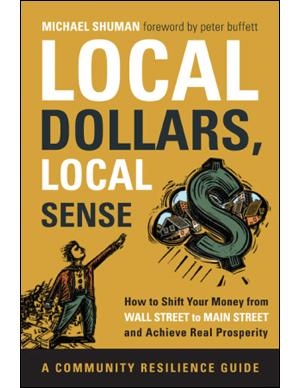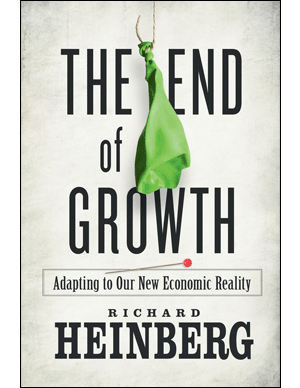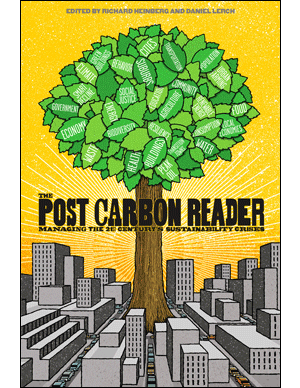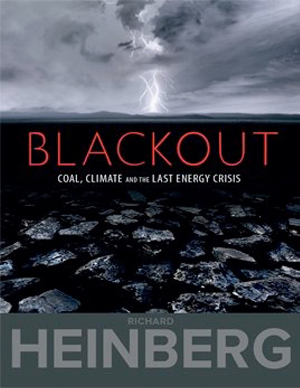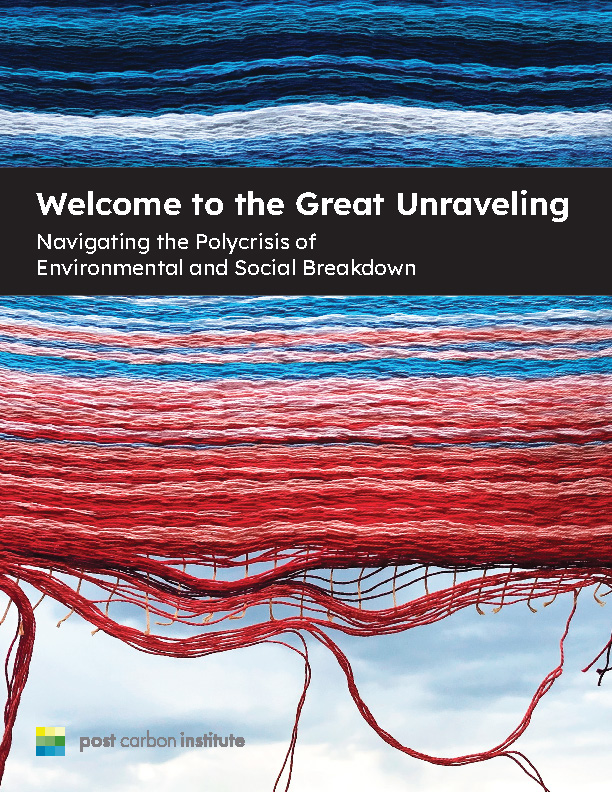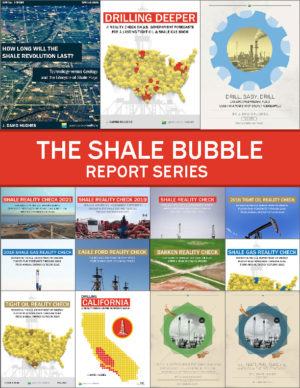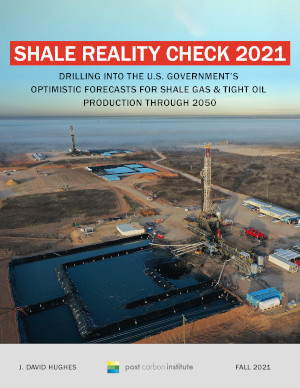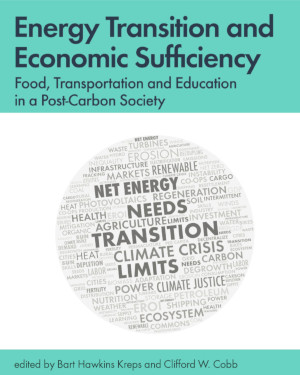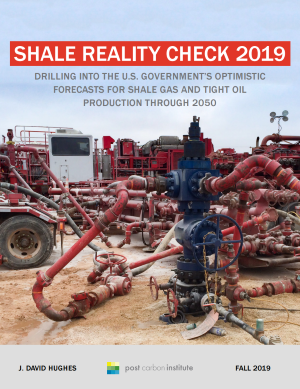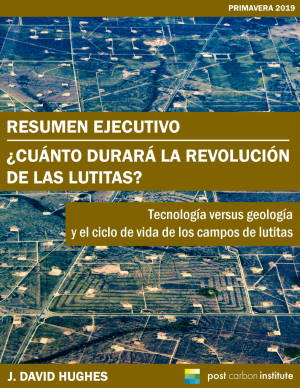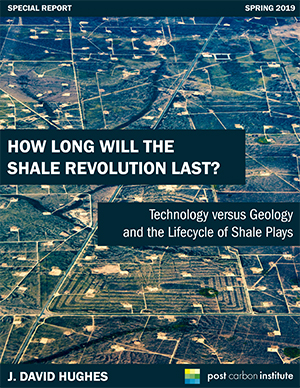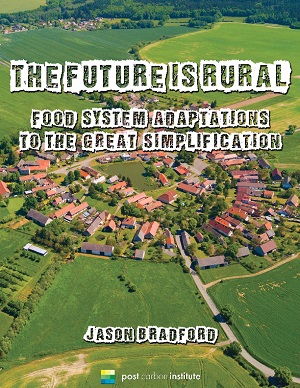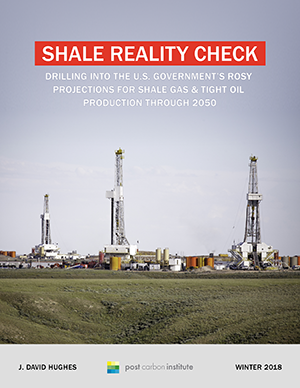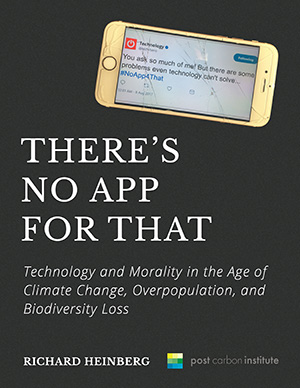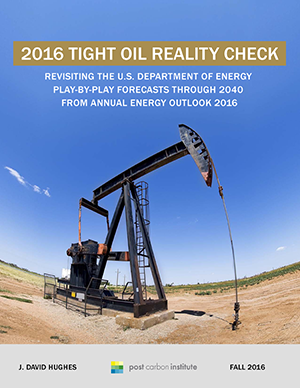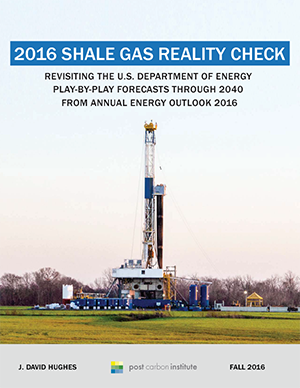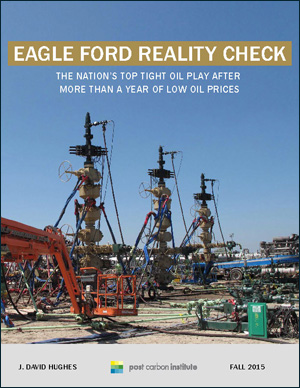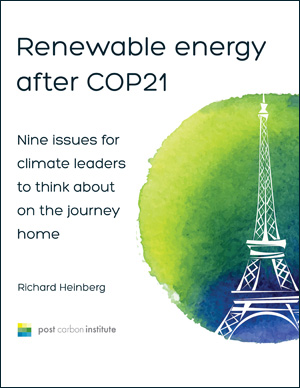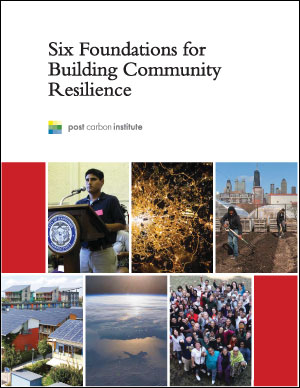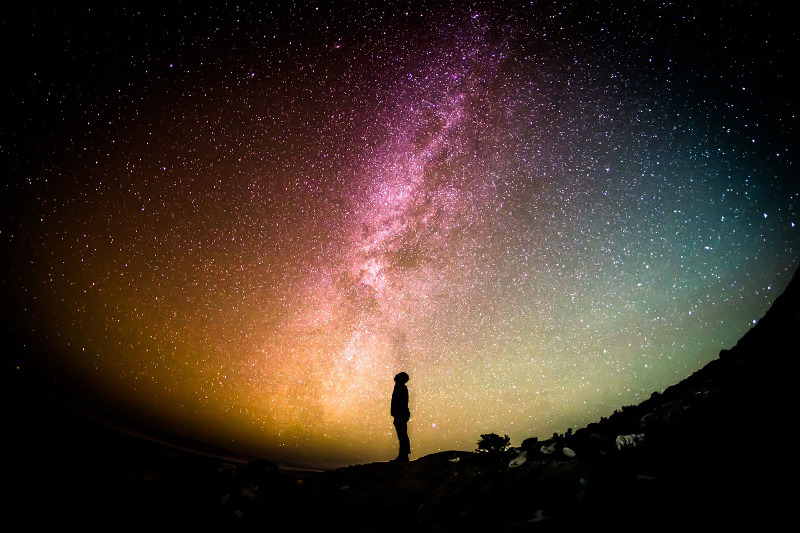
The interrelated crises of the twenty-first century can’t be solved with simple technical adjustments. Understanding and responding to them intelligently requires us to think in terms of systems.
Post Carbon Institute believes that systems thinking is an essential starting point for grappling with the Great Unraveling. Our approach is based in systems thinking and informed by derivative concepts like the “shock doctrine” (Naomi Klein) and the theory of the “diffusion of innovations” (Everett Rogers). And in virtually all our work we emulate systems thinking and aim to educate the public on its value and applications.
Post Carbon Institute Senior Fellow Richard Heinberg describes our systems-based worldview here in this 2018 article:
The Big Picture
By Richard Heinberg, originally published by Resilience.org, December 17, 2018
Humanity has a lot of problems these days. Climate change, increasing economic inequality, crashing biodiversity, political polarization, and a global debt bubble are just a few of our worries. None of these trends can continue indefinitely without leading to a serious failure of our civilization’s ability to maintain itself. Taken together, these metastasizing problems suggest we are headed toward some kind of historic discontinuity.
Serious discontinuities tend to disrupt the timelines of all complex societies (another name for civilizations—that is, societies with cities, writing, money, and full-time division of labor). The ancient Roman, Egyptian, and Mayan civilizations all collapsed. Archaeologists, historians, and systems thinkers have spent decades seeking an explanation for this pattern of failure—a general unified theory of civilizational collapse, if you will. One of the most promising concepts that could serve as the basis for such a theory comes from resilience science, a branch of ecology (the study of the relationship between organisms and their environments).

Why Civilizations Collapse: The Adaptive Cycle
Ecosystems have been observed almost universally to repeatedly pass through four phases of the adaptive cycle: exploitation, conservation, release, and reorganization. Imagine, for example, a Ponderosa pine forest. Following a disturbance such as a fire (in which stored carbon is released into the environment), hardy and adaptable “pioneer” species of plants and small animals fill in open niches and reproduce rapidly.
This reorganization phase of the cycle soon transitions to an exploitation phase, in which those species that can take advantage of relationships with other species start to dominate. These relationships make the system more stable, but at the expense of diversity.
During the conservation phase, resources like nutrients, water, and sunlight are so taken up by the dominant species that the system as a whole eventually loses its flexibility to deal with changing conditions. These trends lead to a point where the system is susceptible to a crash—a release phase. Many trees die, dispersing their nutrients, opening the forest canopy to let more light in, and providing habitat for shrubs and small animals. The cycle starts over.
Civilizations do roughly the same thing. In their early days, complex societies are populated with generalist pioneers (people who do lots of things reasonably well) living in an environment with abundant resources ready to be exploited. These people develop tools to enable them to exploit their resources more effectively. Division of labor and trade with increasingly distant regions also aids in more thorough resource exploitation. Trading and administrative centers, i.e., cities, appear and grow. Money is increasingly used to facilitate trade, while debt enables a transfer of consumption from the future to the present. Specialists in violence, armed with improved weaponry, conquer surrounding peoples.
Complexity (more kinds of tools, more social classes, more specialization) solves problems and enables accumulation of wealth, leading to a conservation phase during which an empire is built and great achievements are made in the arts and sciences. However, as time goes on, the costs of complexity accumulate and the resilience of the society declines. Tax burdens become unbearable, natural resources become depleted, environments become polluted, and conquered peoples become restless. At its height, each civilization appears stable and invincible. Yet it is just at this moment of triumph that it is vulnerable to external enemies and internal discord. Debt can no longer be repaid. Conquered peoples revolt. A natural disaster breaks open the façade of stability and control.
Collapse often comes swiftly, leaving ruin in its wake. But at least some of the components that made the civilization great (including tools and elements of practical knowledge) persist, and the natural environment has opportunity to regenerate and recover, eventually enabling reorganization and a new exploitation phase—that is, the rise of yet another civilization.
Energy Is Everything
Global industrial civilization shows significant signs of being in its conservation phase. Our accomplishments are mind-boggling, but our systems are overstretched, and problems (including climate change, inequality, and political dysfunction) are accumulating and worsening. However, our civilization is different from any of its predecessors. Unlike the ancient Romans, Greeks, Egyptians, Shang Dynasty Chinese, Incas, Aztecs, and Mayans, we have built a civilization that is global in scope. We have invented modes of transportation and communication previously unimaginable. Thanks to advances in public health and agriculture, the total human population has grown to many times its size when Roman armies marched across North Africa, Europe, and Britain. Have we perhaps outgrown the adaptive cycle and escaped natural checks to perpetual expansion?
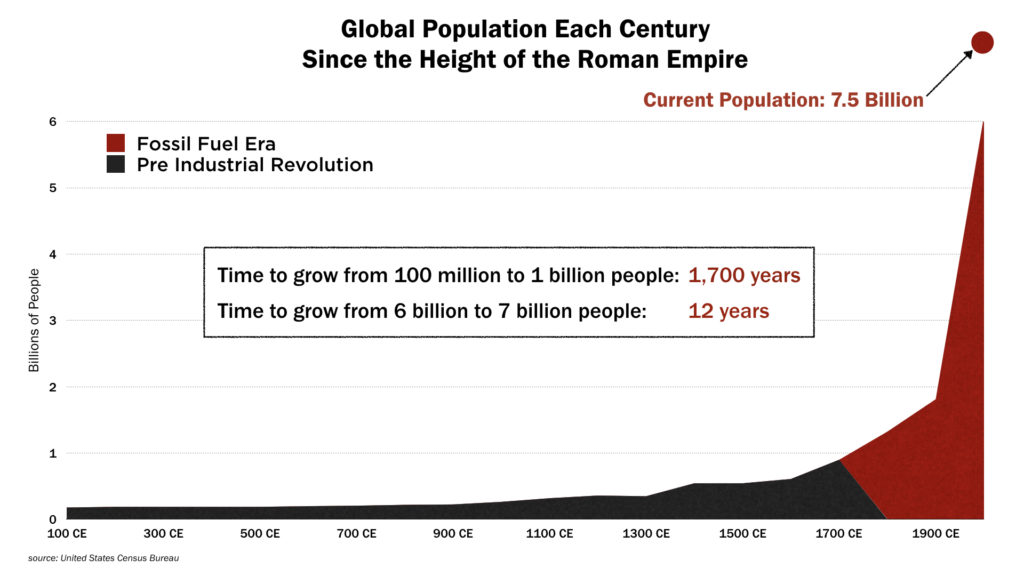
In order to answer the question, we must first inquire why modern civilization has been so successful. The rise of technology, including advances in metallurgy and engineering, certainly played a part. These provided better ways of obtaining and harnessing energy. But it’s the rapid shift in qualities and quantities of energy available to us that really made the difference.
Previously, people derived their energy from annual plant growth (food and firewood), and manipulated their environment using human and animal muscle power. These energy sources were inherently limited. But, starting in the 19th century, new technologies enabled us to access and harness the energy of fossil fuels. And fossil fuels—coal, oil, and natural gas—were able to provide energy in amounts far surpassing previous energy sources.
Energy is everything. All terrestrial ecosystems and all human societies are essentially machines for using (and dissipating) solar energy that has been collected and concentrated through photosynthesis. We like to think that money makes the world go ’round, but it is actually energy that enables us to do anything at all—from merely getting up in the morning to launching a space station. And having lots of energy available cheaply can enable us to do a great deal.
Fossil fuels represent tens of millions of years’ worth of stored ancient sunlight. They are energy-dense, portable, and storable sources of power. Accessing them changed nearly everything about human existence. They were uniquely transformative in that they enabled higher rates of harvesting and using all other resources—via tractors, bulldozers, powered mining equipment, chainsaws, motorized fishing trawlers, and more.
Take just one example. In all previous agrarian civilizations, roughly three-quarters of the population had to farm in order to supply a food surplus to support the other 25 percent—who lived as aristocrats, traders, soldiers, artisans, and so on. Fossil fuels enabled the industrialization and automation of agriculture, as well as longer-distance distribution chains.

Harvesting corn by hand (left) versus harvesting by machine (right). Image sources: The Harvest Cradle by John Linnell, Public Domain (left). Deer Harvester by Wesley Hetrick, Creative Commons Non-Commercial 2.0 Generic License (right).
Today only one or two percent of the U.S. population need to farm full-time in order to supply everyone else with food. The industrialization of food systems has freed up nearly all of the former peasant class to move to cities and take up jobs in manufacturing, marketing, finance, advertising, management, sales, and so on. Thus urbanization and the dramatic expansion of the middle class during the 20th century were almost entirely attributable to fossil fuels.
But fossil fuels have been a bargain with the devil: these are depleting, non-renewable resources, and burning them produces carbon dioxide and other greenhouse gases, changing the climate and the chemistry of the world’s oceans. These are not small problems. Climate change by itself is far and away the most serious pollution dilemma any human society has ever faced, and could lead to crashing ecosystems, failing food systems, and widespread forced human migration.
Replacing fossil fuels with other energy sources is possible in principle, but doing so fully would require massive investment, not just for building solar panels, wind turbines, or nuclear reactors (there are some other serious problems with this latter option), but also for the retooling of manufacturing, transportation, buildings, and food systems to run on electricity instead of solid, liquid, or gaseous fuels. An energy transition is needed, but it’s not happening at even nearly the pace that would be required in order to forestall catastrophic climate change or to prevent economic decline resulting from the depletion of the world’s highest quality oil, coal, and gas resources. Industrial society’s failure to make this energy transition is no doubt due not just to well-funded opposition by the fossil fuel industry, but also to the enormous technical challenge posed, and to the failure of policy makers to champion and implement the carbon taxes and alternative energy subsidies that would be needed.
And so we accelerate toward ecological and economic ruin.
Why It’s So Hard to See that We’re Headed for the Biggest Crash Ever
This is fairly typical of what happens toward the end of the conservation phase of every civilization’s adaptive cycle. Each problem that arises, taken by itself, is usually solvable—at least in principle. But, as problems accumulate, leaders who are accustomed to (and benefit from) the status quo grow increasingly reluctant to undertake the changes to systems and procedures that would be required in order to address worrisome trends. And as those trends are ignored, the level of effort and discomfort needed to reverse them soars. Once solving problems requires too much perceived sacrifice, the only realistic ways to deal with them are to deny their existence or to blame others for them. Blame has the advantages of enabling leaders to look as though they’re actually doing something, and of winning loyalty from their followers. But it does nothing to actually stave off snowballing crises.
It’s easy enough to see how elites could lose touch with reality and miss signals of impending collapse. But why would everyone else follow suit? Recent discoveries in neuroscience help explain why it’s hard for most of us to grasp that we’re on an unsustainable path.
We humans have an understandable innate tendency, when making decisions, to give more weight to present threats and opportunities than to future ones. This is called discounting the future—and it makes it hard to sacrifice now to overcome an enormous future risk such as climate change. The immediate reward of vacationing in another country, for example, is likely to overwhelm our concern about the greenhouse gas footprint of our airline flight. Multiply that future-discounting tendency in one instance by the billions of individual decisions with climate repercussions and you can see why it’s difficult to actually reduce our total greenhouse gas emissions.
We humans are also wired to respond to novelty—to notice anything in our environment that is out of place or unexpected and that might signal a potential threat or reward. Most types of reward increase the level of the neurotransmitter dopamine within the brain. Experiments have found that if an animal’s dopamine receptor genes are removed, it explores less and takes fewer risks—and without some exploration and risk taking, individuals have reduced chances of survival. But the human brain’s dopamine reward system, which evolved to serve this practical function, can be hijacked by addictive substances and behaviors. This is especially problematic in a culture full of novel stimuli specifically designed to attract our interest—such as the hundreds of advertising messages the average child sees each day. We have become addicted to stimuli that our culture has multiplied and refined specifically for the purpose of grabbing our attention (for fun and profit) to such a degree that we barely notice long-term trends that are as threatening as a charging rhino.
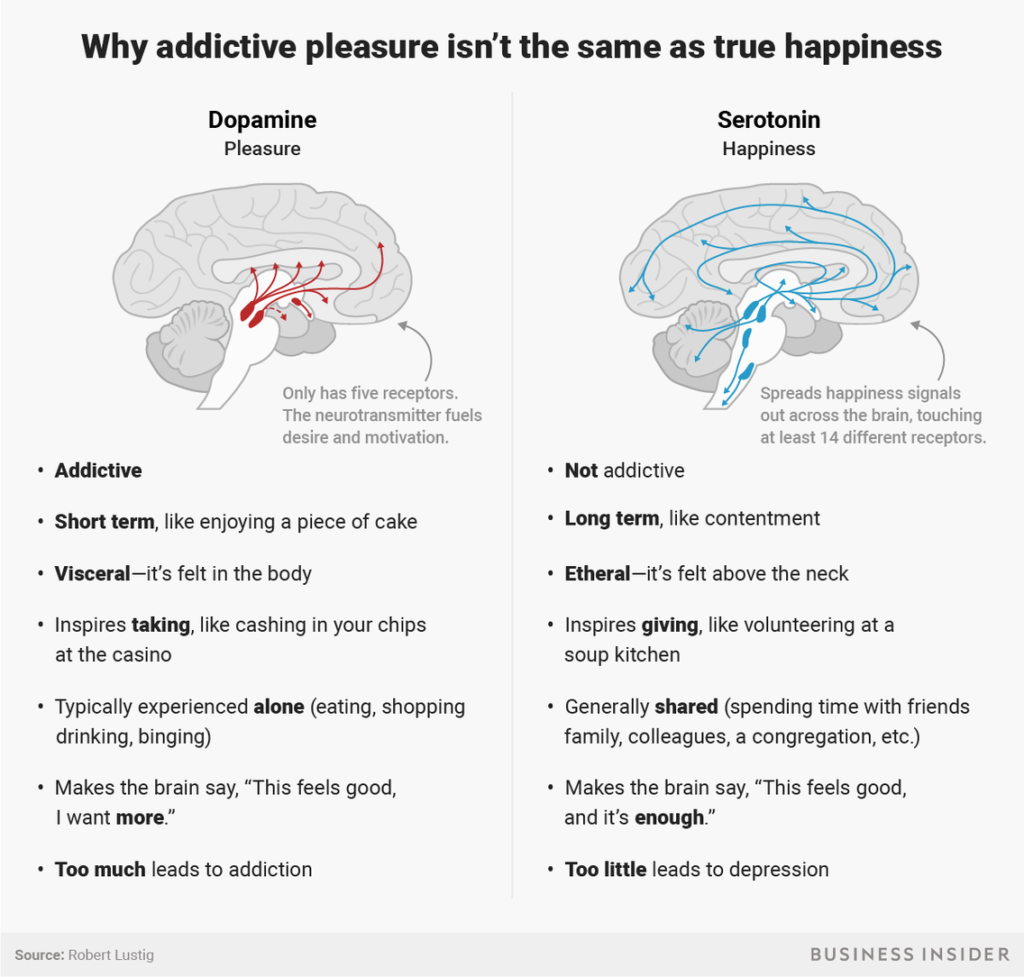
The power holders in society incentivize smart people below them in rank and wealth to normalize the unsustainable, deny impending consequences, and distract one and all from worsening contradictions. Economists who claim that economic growth can continue forever on a finite planet win Nobel Prizes. Politicians who argue that climate change is a hoax attract big campaign contributions. Pundits and entrepreneurs advance along their career paths by asserting that society can grow its way out of climate change and resource depletion traps through “decoupling” (service economies, it is claimed, can expand in perpetuity without requiring additional energy or physical resources). Technology mavens win fame and glory by informing us that artificial intelligence, 3D printing, or Blockchain will usher in the “singularity,” at which point no one will have to work and all human needs and desires can be satisfied by self-reproducing machines.
Denial comes in shades, some of them quite benign. Many thoughtful and informed people acknowledge the threats of climate change, species extinctions, soil depletion, and so on, and insist that we can overcome these threats if we just try harder. They are often on the right track when they propose changes. Elect different, more responsible politicians. Donate to environmental nonprofit organizations. Drive an electric car. Put solar panels on our roofs. Start solar co-ops or regional non-profit utility companies that aim to source all electricity from renewable sources. Eat organic food. Shop at local farmers markets. These are all actions that move society in the right direction (that is, away from the brink of failure)—but in small increments. Perhaps people can be motivated to undertake such efforts through the belief that a smooth transition and a happy future are possible, and that renewable energy will create plentiful jobs and lead to a perpetually growing green economy. There is no point in discouraging such beliefs and their related actions; quite the contrary: they should, if anything, be encouraged. Such practical efforts, however motivated or rationalized, could help moderate collapse, even if they can’t prevent it (a point we’ll return to below). But an element of denial persists nonetheless—denial, that is, of the reality that the overall trajectory of modern industrial society is beyond our control, and that it leads inexorably toward overshoot and collapse.
What to Do?
All of the above may help us better understand why the world seems to be running off the rails. But the implications are horrific. If all this is true, then we now face more-or-less inevitable economic, social, political, and ecological calamity. And since industrial civilization is now global, and human population levels are multiples higher than in any previous century, this calamity could occur on a scale never seen before. Although no one can possibly predict at this point just how complete and awful collapse might actually be, even human extinction is conceivable (though no one can say with any confidence that it is likely, much less inevitable).
This is more than a fragile human psyche can bear. One’s own mortality is hard enough to contemplate. A school of psychology (“terror management theory”) proposes that many of our cultural institutions and practices (religion, values of national identity) exist at least in part to help us deal with the intolerable knowledge of our inevitable personal demise. How much harder must it be to acknowledge signs of the imminent passing of one’s entire way of life, and the extreme disruption of familiar ecosystems? It is therefore no wonder that so many of us opt for denial and distraction.
There’s no question that collapse is a scary word. When we hear it, we tend to think immediately of images from movies like Mad Max and The Road. We assume collapse means a sudden and complete dissolution of everything meaningful. Our reasoning shuts down. But this is just when we need it most.
In reality, there are degrees of collapse, and history shows that the process has usually taken decades and sometimes centuries to unfold, often in stair-steps punctuated by periods of partial recovery. Further, it may be possible to intervene in collapse to improve outcomes—for ourselves, our communities, our species, and thousands of other species. After the collapse of the Roman Empire, medieval Irish monks may have “saved civilization” by memorizing and transcribing ancient texts. Could we, with planning and motivation, do as much and more?

”Desolation” by Thomas Cole (1836), the fourth of a five-part series called The Course of Empire. Public Domain.
Many of the things we could do toward this end are already being done in order to avert climate change and other converging crises. Again, people who voluntarily reduce energy usage, eat locally grown organic food, make the effort to get to know their neighbors, get off the consumer treadmill, reduce their debt, help protect local biodiversity by planting species that feed or shelter native pollinators, use biochar in their gardens, support political candidates who prioritize addressing the sustainability crisis, and contribute to environmental, population, and human rights organizations are all helping moderate the impending collapse and ensure that there will be more survivors. We could do more. Acting together, we could start to re-green the planet; begin to incorporate captured carbon not only in soils, but in nearly everything we make, including concrete, paper, and plastics; and design a new economic system based on mutual aid rather than competition, debt, and perpetual growth. All of these efforts make sense with or without the knowledge that civilization is nearing its sell-by date. How we describe the goals of these efforts—whether as ways of improving people’s lives, as ways to save the planet, as fulfilling the evolutionary potential of our species, as contributing to a general spiritual awakening, or as ways of moderating an inevitable civilizational crash—is relatively unimportant.
However, the Big Picture (an understanding of the adaptive cycle, the role of energy, and our overshoot predicament) adds both a sense of urgency, and also a new set of priorities that are currently being neglected. For example, when civilizations collapse, culturally significant knowledge is typically lost. It’s probably inevitable that we will lose a great deal of our shared knowledge during the coming centuries. Much of this information is trivial anyway (will our distant descendants really suffer from not having the ability to watch archived episodes of Let’s Make a Deal or Storage Wars?). Yet people across the globe now use fragile storage media—computer and server hard drives—to store everything from music to books to instruction manuals. In the event that the world’s electricity grids could no longer be maintained, we would miss more than comfort and convenience; we could lose science, higher mathematics, and history.
It’s not only the dominant industrial culture that is vulnerable to information loss. Indigenous cultures that have survived for millennia are being rapidly eroded by the forces of globalization, resulting in the extinction of region-specific knowledge that could help future humans live sustainably.
Upon whom does the responsibility fall to curate, safeguard, and reproduce all this knowledge, if not those who understand its peril?
Act Where You Are: Community Resilience
We at Post Carbon Institute (PCI) have been aware of the Big Picture since the founding of the organization 15 years ago. We’ve been privileged to meet, and draw upon the insights of, some of the pioneering ecologists of the 1960s, ’70s, and ’80s who laid the basis of our current understanding of resilience science, systems thinking, climate change, resource depletion, and much more. And we’ve strived to convey that understanding to a younger generation of thinkers and activists.
Throughout this time, we have continually grappled with the question, “What plan for action makes the most sense in the context of the Big Picture, given our meager organizational resources?”
After protracted discussion, we’ve hit upon a four-fold strategy.
Encourage resilience building at the community level.
Resilience is the capacity of a system to encounter disruption and still maintain its basic structure and functions. When it is in its conservation phase, a system’s resilience is typically at its lowest level throughout the entire adaptive cycle. If it is possible at this point to build resilience into the human social system, and ecological systems, then the approaching release phase of the cycle may be more moderate and less intense.
Why undertake resilience building in communities, rather than attempting to do so at the national or international level? It’s because the community is the most available and effective level of scale at which to intervene in human systems. National action is difficult these days, and not only in the United States: discussions about nearly everything quickly become politicized, polarized, and contested. It’s at the community level where we most directly interact with the people and institutions that make up our society. It’s where we’re most affected by the decisions society makes: what jobs are available to us, what infrastructure is available for our use, and what policies exist that limit or empower us. And critically, it’s where the majority of us who do not wield major political or economic power can most directly affect society, as voters, neighbors, entrepreneurs, volunteers, shoppers, activists, and elected officials.
PCI has supported Transition Initiatives since its inception as one useful, locally replicable, and adaptable model for community resilience building.
Leave good ideas lying around.
Naomi Klein, in her book The Shock Doctrine, quotes economist Milton Friedman, who wrote:
“Only a crisis—actual or perceived—produces real change. When that crisis occurs, the actions that are taken depend on the ideas that are lying around. That, I believe, is our basic function: to develop alternatives to existing policies, to keep them alive and available until the politically impossible becomes the politically inevitable.”
Friedman and other neoliberal economists have used this “shock doctrine” for decades to undermine regional economies, national governments, and indigenous cultures in order to further the project of corporate-led economic globalization. Klein’s point is that the key to taking advantage of crises is having effective system-changing plans waiting in the wings for the ripe moment. And that’s a strategy that makes sense as society as a whole teeters on the brink of an immensely disruptive shift.
What ideas and skills need to be lying around as industrial civilization crumbles? One collection of ideas and skills that’s already handily packaged and awaiting adoption is permaculture—a set of design tools for living created by ecologists back in the 1970s who understood that industrial civilization would eventually reach its limits. Another set consists of consensus group decision-making skills. The list could go on at some length.
Target innovators and early adopters.
Back in the 1960s, Everett Rogers, a professor of communications, contributed the theory of the Diffusion of Innovations, which describes how, why, and at what rate new ideas, social innovations, and technology spread throughout culture. The key to the theory is his identification of different types of individuals in the population, in terms of how they relate to the development and adoption of something new: innovators, early adopters, early majority, late majority, and laggards.
Innovators are important, but the success of their efforts depends on diffusion of the innovation among early adopters, who tend to be few in number but exceptionally influential in the general population.
At PCI, we have decided to focus our communications on early adopters.
Help people grasp the Big Picture.
Discussions about the vulnerability of civilization to collapse are not for everyone. Some of us are too psychologically fragile. All of us need a break occasionally, and time to feel and process the emotions that contemplating the Big Picture inevitably evokes. But for those able to take in the information and still function, the Big Picture offers helpful perspective. It confirms what many of us already intuitively know. And it provides a context for strategic action.
Pro-Social, Nonpartisan
I’m frequently asked if I have hope for the future. My usual reply is along these lines: hope is not just an expectation of better times ahead; it is an active attitude, a determination to achieve the best possible outcome regardless of the challenges one is facing. PCI Fellow David Orr summed this up best when he wrote, “Hope is a verb with its sleeves rolled up.”
However, if that’s as far as the discussion goes, merely redefining “hope” may seem facile and unsatisfying. The questioner wants and needs reasonable grounds for believing that an outcome is possible that is something other than horrific. There is indeed evidence along these lines, and it should not be ignored.
Steven Pinker, in his book The Better Angels of Our Nature, argues that we humans are becoming more peaceful and cooperative. Now, it could be argued that any decline in violence during the past few decades can be seen as yet another indication that civilization is in a conservation phase of the adaptive cycle: we have attained a balance of power, facilitated by the wealth flowing ultimately from fossil fuels; perhaps violence is simply being held in abeyance until the dam breaks and we head into the release phase of the cycle. Nevertheless, evolution is real, and for humans it occurs more rapidly via culture than through genes. It is entirely possible, therefore, that we humans are rapidly evolving to live more peacefully in larger groups.
Earlier I explained how the findings of neuroscience help us understand why so many of us turn to denial and distraction in the face of terrible threats to civilization’s survival. Neuroscience also offers good news: it teaches us that cooperative impulses are rooted deep in our evolutionary past, just like competitive ones. Self-restraint and empathy for others are partly learned behaviors, acquired and developed in the same way as our capacity for language. We inherit both selfishness and the capacity for altruism, but culture generally nudges us more in the direction of the latter, as parents are traditionally encouraged to teach their children to share and not to be wasteful or arrogant.
Disaster research informs us that, in the early phases of crisis, people typically respond with extraordinary degrees of cooperation and self-sacrifice (I witnessed this in the immediate aftermath of wildfires in my community of Santa Rosa, California). But if privation persists, they may turn toward blame and competition for scarce resources.
All of this suggests that the one thing that is most likely to influence how our communities get through the coming meta-crisis is the quality of relationships among members. A great deal depends on whether we exhibit pro-social attitudes and responses, while discouraging blame and panic. Those of us working to build community resilience need to avoid partisan frames and loaded words, and appeal to shared values. Everyone must understand that we’re all in this together. The Big Picture can help here, if it aids people in grasping that the collapse of civilization is not any one group’s fault. It is only by pulling together that we can hope to salvage and protect what is most intrinsically valuable about our world, and perhaps even improve lives over the long term.
Hard times are in store. But that doesn’t mean there’s nothing we can do. Each day of relative normalcy that remains is an occasion for thankfulness and an opportunity for action.
Originally posted at Resilience.org
Image: The Milky Way, by Greg Rakozy via Unsplash.

